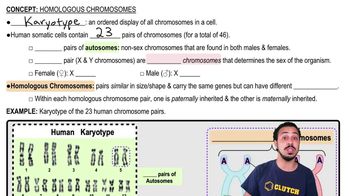Table of contents
- 1. Introduction to Biology2h 42m
- 2. Chemistry3h 40m
- 3. Water1h 26m
- 4. Biomolecules2h 23m
- 5. Cell Components2h 26m
- 6. The Membrane2h 31m
- 7. Energy and Metabolism2h 0m
- 8. Respiration2h 40m
- 9. Photosynthesis2h 49m
- 10. Cell Signaling59m
- 11. Cell Division2h 47m
- 12. Meiosis2h 0m
- 13. Mendelian Genetics4h 44m
- Introduction to Mendel's Experiments7m
- Genotype vs. Phenotype17m
- Punnett Squares13m
- Mendel's Experiments26m
- Mendel's Laws18m
- Monohybrid Crosses19m
- Test Crosses14m
- Dihybrid Crosses20m
- Punnett Square Probability26m
- Incomplete Dominance vs. Codominance20m
- Epistasis7m
- Non-Mendelian Genetics12m
- Pedigrees6m
- Autosomal Inheritance21m
- Sex-Linked Inheritance43m
- X-Inactivation9m
- 14. DNA Synthesis2h 27m
- 15. Gene Expression3h 20m
- 16. Regulation of Expression3h 31m
- Introduction to Regulation of Gene Expression13m
- Prokaryotic Gene Regulation via Operons27m
- The Lac Operon21m
- Glucose's Impact on Lac Operon25m
- The Trp Operon20m
- Review of the Lac Operon & Trp Operon11m
- Introduction to Eukaryotic Gene Regulation9m
- Eukaryotic Chromatin Modifications16m
- Eukaryotic Transcriptional Control22m
- Eukaryotic Post-Transcriptional Regulation28m
- Eukaryotic Post-Translational Regulation13m
- 17. Viruses37m
- 18. Biotechnology2h 58m
- 19. Genomics17m
- 20. Development1h 5m
- 21. Evolution3h 1m
- 22. Evolution of Populations3h 53m
- 23. Speciation1h 37m
- 24. History of Life on Earth2h 6m
- 25. Phylogeny2h 31m
- 26. Prokaryotes4h 59m
- 27. Protists1h 12m
- 28. Plants1h 22m
- 29. Fungi36m
- 30. Overview of Animals34m
- 31. Invertebrates1h 2m
- 32. Vertebrates50m
- 33. Plant Anatomy1h 3m
- 34. Vascular Plant Transport1h 2m
- 35. Soil37m
- 36. Plant Reproduction47m
- 37. Plant Sensation and Response1h 9m
- 38. Animal Form and Function1h 19m
- 39. Digestive System1h 10m
- 40. Circulatory System1h 49m
- 41. Immune System1h 12m
- 42. Osmoregulation and Excretion50m
- 43. Endocrine System1h 4m
- 44. Animal Reproduction1h 2m
- 45. Nervous System1h 55m
- 46. Sensory Systems46m
- 47. Muscle Systems23m
- 48. Ecology3h 11m
- Introduction to Ecology20m
- Biogeography14m
- Earth's Climate Patterns50m
- Introduction to Terrestrial Biomes10m
- Terrestrial Biomes: Near Equator13m
- Terrestrial Biomes: Temperate Regions10m
- Terrestrial Biomes: Northern Regions15m
- Introduction to Aquatic Biomes27m
- Freshwater Aquatic Biomes14m
- Marine Aquatic Biomes13m
- 49. Animal Behavior28m
- 50. Population Ecology3h 41m
- Introduction to Population Ecology28m
- Population Sampling Methods23m
- Life History12m
- Population Demography17m
- Factors Limiting Population Growth14m
- Introduction to Population Growth Models22m
- Linear Population Growth6m
- Exponential Population Growth29m
- Logistic Population Growth32m
- r/K Selection10m
- The Human Population22m
- 51. Community Ecology2h 46m
- Introduction to Community Ecology2m
- Introduction to Community Interactions9m
- Community Interactions: Competition (-/-)38m
- Community Interactions: Exploitation (+/-)23m
- Community Interactions: Mutualism (+/+) & Commensalism (+/0)9m
- Community Structure35m
- Community Dynamics26m
- Geographic Impact on Communities21m
- 52. Ecosystems2h 36m
- 53. Conservation Biology24m
15. Gene Expression
Genetic Code
Problem 2
Textbook Question
Which of the following correctly ranks the structures in order of size, from largest to smallest?
a. Gene–Chromosome–Nucleotide–Codon
b. Chromosome–Gene–Codon–Nucleotide
c. Nucleotide–Chromosome–Gene–Codon
d. Chromosome–Nucleotide–Gene–Codon
 Verified step by step guidance
Verified step by step guidance1
Understand the hierarchy of genetic structures: A chromosome is the largest structure, containing many genes. Genes are segments of DNA that code for proteins, and they are composed of sequences of nucleotides. Codons are specific sequences of three nucleotides that correspond to amino acids or stop signals during protein synthesis.
Analyze the options provided. Each option lists the structures in a specific order. To determine the correct ranking, compare the relative sizes of the structures based on the hierarchy described in the first step.
Start with the largest structure, which is the chromosome. Eliminate any options that do not list the chromosome as the largest structure.
Next, identify the second largest structure, which is the gene. Eliminate any options that do not list the gene immediately after the chromosome.
Finally, confirm the order of the smaller structures: codons (three-nucleotide sequences) are larger than individual nucleotides. Use this information to identify the correct ranking from the options provided.
 Verified video answer for a similar problem:
Verified video answer for a similar problem:This video solution was recommended by our tutors as helpful for the problem above
Video duration:
1mPlay a video:
Was this helpful?
Key Concepts
Here are the essential concepts you must grasp in order to answer the question correctly.
Chromosomes
Chromosomes are long, thread-like structures made of DNA and proteins that contain genetic information. In humans, each cell typically contains 23 pairs of chromosomes, which house many genes. They are the largest structures in the hierarchy of genetic material, serving as the organizational units for DNA.
Recommended video:
Guided course

Homologous Chromosomes
Genes
Genes are segments of DNA located on chromosomes that encode instructions for building proteins. Each gene can vary in size and is responsible for specific traits or functions in an organism. They are smaller than chromosomes but larger than codons and nucleotides.
Recommended video:
Guided course

Genes & Alleles
Nucleotides and Codons
Nucleotides are the basic building blocks of DNA and RNA, consisting of a sugar, a phosphate group, and a nitrogenous base. Codons are sequences of three nucleotides that correspond to specific amino acids during protein synthesis. Codons are smaller than nucleotides, as they are formed by combinations of three nucleotides.
Recommended video:
Guided course

Nucleotides
Related Videos
Related Practice
Multiple Choice
Bacteria can transcribe and translate human genes to produce functional human proteins because __________.
1833
views


